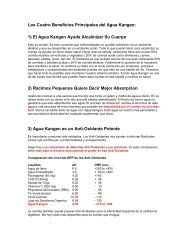ACID-ALKALINE BALANCE: ROLE IN CHRONIC ... - My Kangen Tools
ACID-ALKALINE BALANCE: ROLE IN CHRONIC ... - My Kangen Tools
ACID-ALKALINE BALANCE: ROLE IN CHRONIC ... - My Kangen Tools
You also want an ePaper? Increase the reach of your titles
YUMPU automatically turns print PDFs into web optimized ePapers that Google loves.
Tanner and Tanner: Citrate treatment in PKD rats 1865<br />
Table 2. Acid-base measurements in six-month-old normal rats and rats with PKD<br />
Normal rats<br />
Rats with PKD<br />
Tap water KCitr Tap water KCitr<br />
(N 14) (N 13) (N 13) (N 12)<br />
Arterial pH 7.380.03 7.390.06 7.300.05 b 7.390.04 d<br />
Arterial P CO2 mm Hg 374 40 6 39 5 37 4<br />
Arterial plasma [HCO 3 ] mEq/L 222.5 242.1 191.9 a 222.5 c<br />
Urine pH 5.960.22 6.430.25 b 5.890.22 6.390.24 d<br />
Values are means SD.<br />
a<br />
P 0.01 and b P 0.001 compared with normal rats on tap water<br />
c<br />
P 0.01 and d P 0.001 compared with rats with PKD on tap water<br />
Table 3. Renal citrate handling in six-month-old normal rats and rats with PKD<br />
Normal rats<br />
Rats with PKD<br />
Tap water KCitr Tap water KCitr<br />
(N 9) (N 8) (N 8) (N 7)<br />
Arterial [citrate] mmol/L 0.0860.018 0.0810.013 0.1540.038 c 0.0770.015 g<br />
Citrate extraction 0.340.08 0.330.10 0.210.08 b 0.330.09<br />
Urine [citrate] mmol/L 0.080.06 0.700.54 c 0.650.33 c 1.040.57<br />
Filtered citrate nmol/min 14931 15837 10718 b 16139 f<br />
Excreted citrate nmol/min 2.32.1 13.48.6 c 25.416.9 c 43.620.3 d<br />
Reabsorbed citrate nmol/min 14630 14537 8217 c 11724<br />
FE citrate % 1.41.0 8.85.7 c 23.012.8 c 26.36.7 e<br />
Citrate consumption nmol/min 25766 267137 14157 b 20268<br />
Peritubular citrate uptake nmol/min 11062 122108 5941 8573<br />
Cortical [citrate] mmol/kg wet weight a 0.2690.104 0.2640.069 0.8250.516 c 0.2710.071 g<br />
Values are means SD. Kidney data are for the left kidney.<br />
a<br />
Measurements in the four groups were done in 8, 7, 9, and 7 rats, respectively<br />
b<br />
P 0.05 and c P 0.001 compared with normal rats on tap water<br />
d<br />
P 0.01 and e P 0.001 compared with normal rats on KCitr<br />
f<br />
P 0.05 and g P 0.001 compared with rats with PKD on tap water<br />
with PKD; intake of this solution was associated with an month of age, results in normal GFR and renal blood<br />
acidic urine pH.<br />
flow in six-month-old animals (Table 1). These results<br />
By contrast, substitution of sodium for potassium in extend our previous study in which a beneficial effect of<br />
the drinking solution yielded results similar to KCitr. KCitr treatment was seen in rats treated from one to<br />
GFR in the rats with PKD, 532 96 L/min-100 g body three months of age [7]. Long-term KCitr therapy, started<br />
weight, was normal. Urine pH averaged 6.57 0.23 (N at the age of one month, prolongs the survival time of rats<br />
4) in normal rats and 6.51 0.33 (N 4) in rats with with PKD (Fig. 2). We do not know whether initiation of<br />
PKD. The renal histology of rats with PKD that had treatment at an older age, when some degree of renal<br />
consumed the sodium citrate salt (data not shown) was impairment is already present, would also be effective<br />
identical to that seen in rats of the same age that had in slowing the progression of PKD.<br />
consumed KCitr [7]. These results clearly indicate that<br />
it is the intake of citrate or citric acid, not the provision Renal handling of citrate<br />
of extra potassium in the diet, that is responsible for the We studied renal handling of citrate in an attempt to<br />
beneficial effect of KCitr.<br />
understand why it was effective. Some of our results<br />
With the administration of K 3 citrate (potassium ci- were not expected (1) citrate concentrations in plasma,<br />
trate but no citric acid), GFR was maintained as with<br />
renal cortical tissue, and urine were all higher than nor-<br />
KCitr. Urine pH in the rats on K 3 citrate solution was<br />
mal in untreated rats with PKD; and (2) KCitr treatment<br />
6.08 0.25 (N 2) in normal rats and 5.83 0.35 (N <br />
of rats with PKD led to decreases in plasma and tissue<br />
5) in rats with PKD. Overall, the results demonstrate<br />
citrate levels, probably as a consequence of more normal<br />
that alkalinizing citrate salts prevent a decline in GFR<br />
renal function.<br />
in rats with PKD.<br />
Plasma citrate. Two factors may explain the elevated<br />
arterial plasma citrate concentration in untreated rats<br />
DISCUSSION<br />
with PKD (Table 3). First, renal consumption of citrate<br />
This study demonstrates that chronic treatment of rats was decreased. The kidneys are the major site of citrate<br />
which have PKD with a KCitr solution, starting at one utilization in the body [22]. Second, rats or patients with



